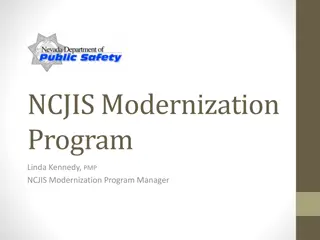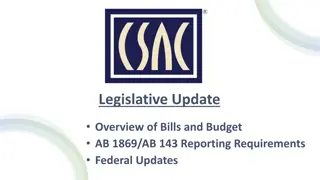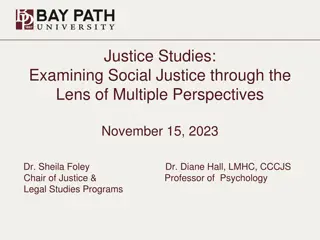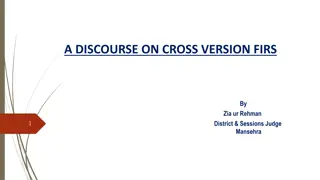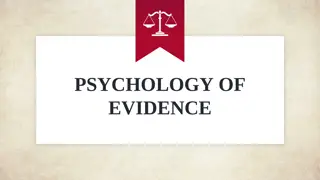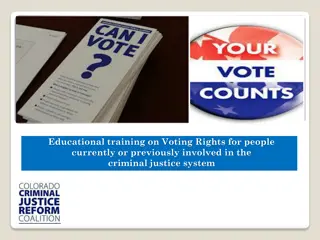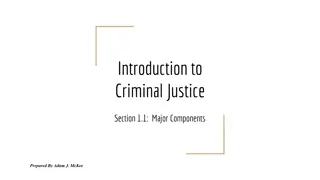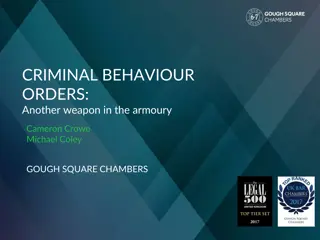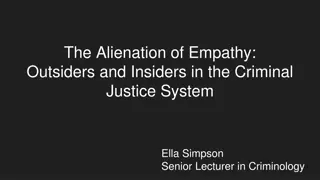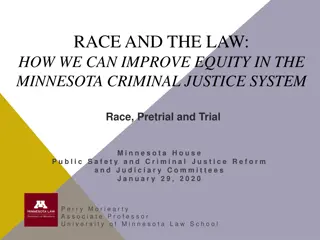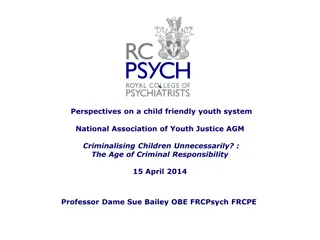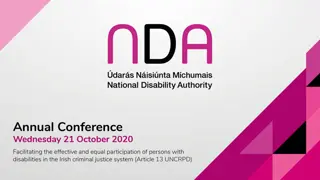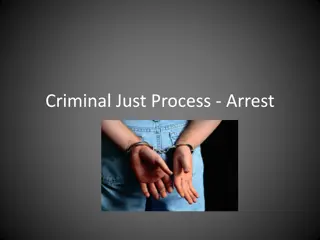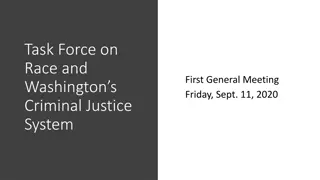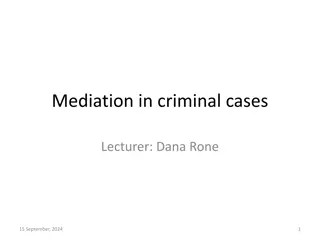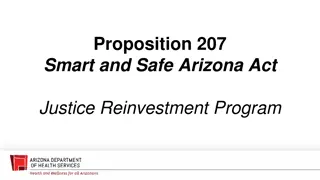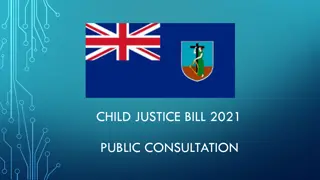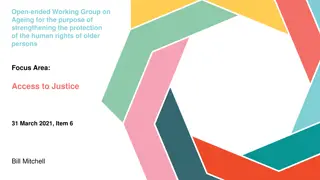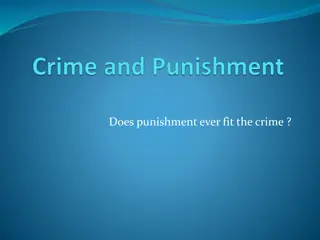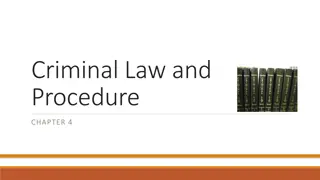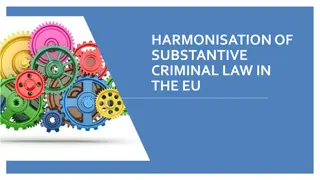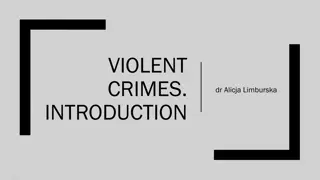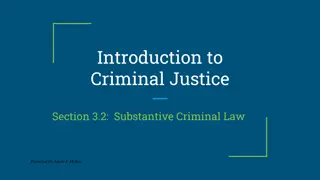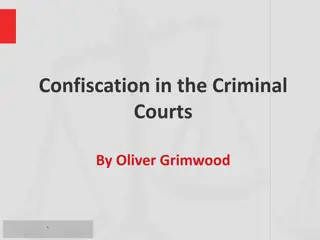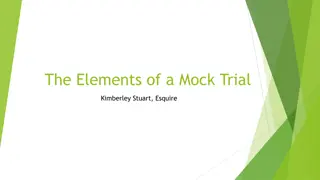Overview of Criminal Justice Realignment in California
California's Criminal Justice Realignment, implemented in September 2011, involves shifting custody of certain non-violent, non-serious, non-sex offenders to county control. This initiative also establishes Postrelease Community Supervision and changes the state parole revocation process. The reform is aimed at reducing prison population, managing costs, and improving community corrections partnerships. Funding sources include diverted state sales tax, vehicle license fees, and state General Fund dollars.
Download Presentation

Please find below an Image/Link to download the presentation.
The content on the website is provided AS IS for your information and personal use only. It may not be sold, licensed, or shared on other websites without obtaining consent from the author. Download presentation by click this link. If you encounter any issues during the download, it is possible that the publisher has removed the file from their server.
E N D
Presentation Transcript
Criminal Justice Realignment: What Counties Need to Know to Implement Presented: September 2011
What is Criminal Justice Realignment? 2 Shifts custody of felons sentenced for non-violent, non- serious, non-sex offenses to county control unless excluded by statute Establishes Postrelease Community Supervision (PRCS) Changes state parole revocation process Tasks Community Corrections Partnerships (CCPs) with planning for the change and implementing local plans Funded by diverted state sales tax, specified vehicle license fee proceeds, and some state General Fund dollars
Recent History 3 Costs of State Prison System Growing Funds for Correctional Activities Diminishing Several Class Action Suits Filed Against California Recidivism Rates at 70% Three-Judge Panel Order to Reduce Prison Population
Prior Criminal Justice Reform Proposals 4 Eliminate Parole Eliminate Parole and Shift to Probation Establish State Contract for Local Jail Beds Shift Felons with Sentences of Three Years or Less to County Jail Create a Sentencing Commission
When Does Criminal Justice Realignment Take Effect? 5 Eligible felonies sentenced to county jail: applies to any person sentenced on or after October 1, 2011. Changes in custody credits: applies to custody for any offense committed on or after October 1, 2011. Postrelease community supervision: applies to any eligible person released from state prison on or after October 1, 2011. Revocation of postrelease community supervision by superior court: on petition by supervising agency (probation department) on or after October 1, 2011. Revocation of parole by superior court: on petition by state parole on or after July 1, 2013.
How is Criminal Justice Realignment Funded? 6 Counties Redirection of existing resources Dedication of 1.0625% existing state sales tax Redirection of VLF administrative funds and portion of 0.65 rate Separate allocation for programmatic aspects ($354.3 million) and for DA/PD revocation responsibilities ($12.7 million) One-time planning ($7.9 million) and start-up grants ($25 million) Allocation formula applicable only for 2011-2012 Constitutional protections still needed
How is Criminal Justice Realignment Funded? 7 Courts Not part of realignment funding Separately funded from state General Fund as augmentation of judicial branch budget $17.7 million for estimated revocation petition caseload Judicial Council to allocate to each court based on percentage of estimated caseload Allocation basis is for 2011-2012 only
Sentencing and Custody 8 or Who Goes Where and For How Long?
Who may Sentenced to County Jail? (Prison ineligible) 9 Non-non-nons (N3) without disqualifying offenses (current or prior) Non-violent felons Non-serious felons Non-sex offenders Revises the definition of felony to include certain crimes that are punishable in jail Time served in jail, probation, or alternative custody instead of prison
Who is State Prison Eligible? 10 The following sentences may be served in state prison: Current or prior serious or violent felonies as described in PC 1192.7(c) or 667.5(c) Defendant is required to register as a sex offender pursuant to PC 290 PC 186.11 (white collar crime) sentence enhancement Excludes certain other specified crimes, including felony domestic violence, felony stalking, and solicitation of murder
MYTH 11 Prison inmates will be released early to counties on October 1, 2011. No. In reality, no inmates in prison on October 1, 2011 will be transferred to local jurisdiction prior to their release date as a result of realignment.
MYTH 12 Only persons sentenced to three years or less for felonies are eligible to go to county jail. No. All qualifying persons sentenced pursuant to PC 1170(h), regardless of sentence length, go to county jail or other local disposition as ordered by the court.
Sentencing Decisions for N3 13 What changes? The place one serves the sentence Rules of sentencing and sentence length do not change Split sentence imposed sentence of combined jail time with the remainder on local supervision Prison prior attaches to sentences under 1170(h) (everything but felony probation) Split sentences cannot be longer than the original sentence when combining custody and supervision time.
Sentencing Decisions for N3 14 What does not change? Felony probation Existing alternatives (pretrial diversion, Deferred Entry of Judgment) Rules of sentencing and sentence length
Sentencing Considerations 15 Full term to be served in jail Full term of felony probation Split Sentence conditions and procedures generally applicable to persons placed on probation supervision shall be mandatory No good time credits for the supervision portion but does apply to the custody portion Not probation, not parole but operationally it will feel like probation
MYTH 16 When N3 get released from county jail, they go on local parole or probation. No. There is NO automatic term of supervision imposed on N3 when they are released from county jail. Exceptions: traditional felony probation and split sentences
Custody Decisions/Population Management for N3 17 Enhanced local custody and supervision tools: Alternative custody tools for county jails Home detention for low-level offenders Counties may contract for beds: With CDCR (healthy level II/III $77.00 day) With other counties With public Community Correctional Facilities (CCFs) With Fire Camps (proposal $46.19/day) Counties MAY NOT contract back parole revocations
Postrelease Community Supervision 18 It s Not Parole and It s Not Probation
CDCR Operative Dates for Screening Process 19 Inmates being released from prison on a commitment on or after October 1, 2011, will be screened for PRCS or Parole. Parolees who are being held for a parole violation in State prison on October 1, 2011, will be screened if they have a release date on or after November 1, 2011. Parolees and parole violators who are not housed in CDCR custody will not be screened.
Postrelease Community Supervision (PRCS) 20 Who will be released from state prison to local supervision? Current non-violent, non-serious offenders (can have serious or violent offenses in history) Some sex offenders Persons who, prior to October 1, 2011, would have been non-revocable parolees (NRPs) CDCR must notify counties who is being released at least 30 days prior
Key CDCR Determinations 21 Does the inmate qualify for PRCS What is the county of last legal residence (CLLR) What are the terms and conditions of release (general and special)
BREAK TIME 15 MINS
Are they a PRCS? 23 Determination of an inmate s status after release, state or local
CDCR Screening Process 24 Starts 180 prior to calculated release date Completed by Correctional Counselors in the institutions The CDCR form 611 Release Program Study determines if the inmate is PRCS eligible Counties will receive a pre-release packet if the 611 determines PRCS Counties will be mailed a post-release packet within 2 days of release Counties need to complete the reporting instruction portion of the RPS and return the form to the institution
Special determinations to access PRCS eligibility 25 High Risk Sex Offenders (HRSO) All inmates who are required to register pursuant to Penal Code Section 290 For male inmates the Static 99 tool will be utilized For female inmates the Female Sex Offender Risk Assessment (FSORA) tool will be utilized Mentally Disordered Offenders (MDO) This must be done close to time of release If an inmate is identified as PRCS initially and is subsequently determined to be MDO, the county will be notified the inmate is no longer being sent to PRCS. PC 3000(b)(2) (Longer Parole Tail than 3 years)
CDCR Form 611, RPS Section III., Supervision Determination by Correctional Counselor Section IV., Supervisor Review and Approval of Screening Determination
What if its Wrong? 27 PRCS county contact should contact Correctional Counselor at the institution If still disagree contract Tanya Rothchild Please review the packets carefully, especially first batch as the process is new for everyone and mistakes could be made
PRCS Eligible, now what? 28 Where do they go? Which County?
County of Last Legal Residence 29 Penal Code Section 3003 states inmates released from custody shall be sent to the county of their last legal residence prior to incarceration The Probation Officer s Report shall be primary resource. The arrest report shall be used if there is no POR available If inmate is serving a term for an in-custody offense, the county of the institution is NOT the CLLR If the inmate was transient or from out of state when committed, CDCR advises its staff to utilize the County of Commitment.
Can an inmate request a different county of residence beside CLLR? 30 Yes in the 611 RPS, if an inmate identifies a different county that information will be sent to the CLLR county Legally, the inmate will be released to the CLLR but there is a provision to start a county transfer process at this point However, regardless of where the inmate requested to reside, if the reporting instructions indicate an address in the CLLR. The inmate will be told to report as directed. (A out of county process may be initiated at any point)
Out of County Placement/Transfer 31 The inmate s residence plan includes where he/she would like to be released. If he/she does not, it may state transient or none meaning they have no home to reside within the CLLR. As the supervising agency, it is the county s decision whether this placement is approved. If it is not, the county needs to let the institution know to deny the inmate s request and provide and suitable alternative address if an acceptable one was not provided.
How does the Out of County Transfer work between counties 32 NO 1203.9 Process!!!!! Supervising Entity Sending Determines whether the offender does permanently reside out of county Must approve of the new address does not violate terms and conditions If yes, must transmit prison packet within 2 weeks to Supervising Entity Receiving Supervising Entity Receiving Upon verification, shall accept JURISDICTION Residence = customarily lives exclusive of employment, school or other temp purpose
PRCS Eligible; CLLR Determined. 33 What terms and conditions attach?
CDCR Form Notice of Conditions 34 The 1515-CS is identical for all inmates as it outlines the conditions reflected in the statute. A copy of the signed document, if not in the pre-release packet, will be included in the post release packet. If an offender did NOT sign the conditions, the county would be notified by the institution staff and the inmate will be held until signs or credits expire After screening processes began, a number of counties requested that the CDCR Form 1515-CS, Notice of Conditions of PRCS, be included in the pre-release packet instead of the post release packet.
What about Special Conditions 35 Counties may send to the institution via fax Special Conditions of Release that the inmate needs to have prior to release. CDCR requests the fax cover sheet provided to designated county contacts be utilized for this purpose to ensure appropriate handling by institution staff. Special conditions will be issued to the inmates by the correctional counselors The signed conditions will be returned to the counties pursuant to the direction provided on the form.
Things CDCR will continue to do for PRCS 36 CDCR will continue to advise inmate s of any registration requirements CDCR will also provide pre-release notifications to victims and law enforcement as required by statute Will not release any high risk on weekends or holidays Prior to an inmate being released, CDCR staff will enter statutorily required information into the Parole Law Enforcement Automated Data System (LEADS). CDCR will provide information to DOJ for entry into CLETS (further discussion on data entry)
Day of Release 37 What to expect
What the Inmate should expect 38 On an inmate s day of release, he or she is processed out of the institution and taken to the local bus station for transport to their county of last legal residence. Inmate s may chose to have someone pick them up. Each inmate is given $200 in release funds (commonly referred to as gate money ). The inmate is required to utilize these funds for the purchase of the bus ticket.
What should county expect 39 PRCS should have all their reporting instructions and information regarding their supervising entity contact If CDCR mental health staff advise the custody staff within the prison that an inmate appears to either pose harm to themselves or the public upon release, CDCR institution staff will advise the county prior to the offender s release.
What about complex cases 40 If the county identifies information on the 611 form regarding an inmate s medical or mental health condition, they can contact the designated representative at the institution May request to move difficult to transport PRCS to a closer CDCR institution to arrange for county pick up There will be additional work on some of the high need medical/MH inmates
BREAK TIME 10 MINS
Now PRCS is in your county 42 Supervision, Revocation, Discharge process
PRCS Supervision 43 Supervision levels and case plans not mandated by statute but determined by supervising agency (probation department) General statutory conditions to be agreed to by offender prior to release from prison Permits CDCR to hold inmate until credits exhausted until they sign Adds term that they may be arrested by peace officer or probation officer with or without a warrant when there is PC for violation Supervising agency may send special conditions to CDCR prior to release must have a nexus to the offender Explicitly authorizes EM as possible condition May want to add restitution provisions
PRCS Supervision 44 Supervising agency has authority to handle all intermediate sanctions without court involvement, up to and including flash incarceration (up to 10 consecutive days) Flash incarceration is not subject to credits Not in statute, but CDCR meets the legal requirement of a probable cause review process by ensuring within 48 hours a paper review by a supervising agent to validate the arresting agents decision Authorizes any peace officer to arrest for violation with PC but only supervising entity can seek a warrant Tolls the PRCS time for absconders if warrant outstanding
PRCS Supervision 45 Authorizes any peace officer to arrest for violation with PC but only supervising entity can seek a warrant This waiver was added to the terms and conditions Peace officer must bring the person before the supervising entity for approval to hold (either under flash or starting a revocation proceeding) Tolls the PRCS time for absconders if warrant outstanding
PRCS Revocation Process 46 Only supervising agency can petition for revocation Each supervising agency must establish an assessment process to review applicability of intermediate sanctions authorized by law prior to filing a petition Revocations capped at 180 days per event Jail only, no return to prison, custody credits apply At completion of revocation time, offenders return to PRCS (if they were revoked and reinstated) if there is available time left on the three-year tail
The Judiciarys Role in PRCS 47 Judicial Council is to adopt rules of court and forms to handle final revocation process Courts involvement starts with filing of a petition for final revocation of supervision Prior to filing petition, supervising agency must assess and determine that intermediate sanctions are inappropriate Courts will be authorized to appoint hearing officers for these cases Hearing officers may modify conditions, revoke to jail (not prison) for up to 180 days, or refer to an evidence-based program such as a reentry court
MYTH 48 The sanction for a revocation of traditional adult probation is now capped at 180 days in jail. No. Realignment does not affect felony probation sanctions. Persons on felony probation for an offense that is ineligible for prison cannot be revoked to state prison, but will serve their revocation in county jail.
PRCS Discharge Process 49 Discharges by operation of law at the end of 3 years Supervising agency (probation department) may discharge after 6 consecutive months of no violations Violations = custodial sanctions Must discharge after a continuous year served with no violations within 30 days Violations = custodial sanctions Courts WILL NOT be involved in the discharge process for either PRCS or parolees
State Parole 50 Yes, it still exists
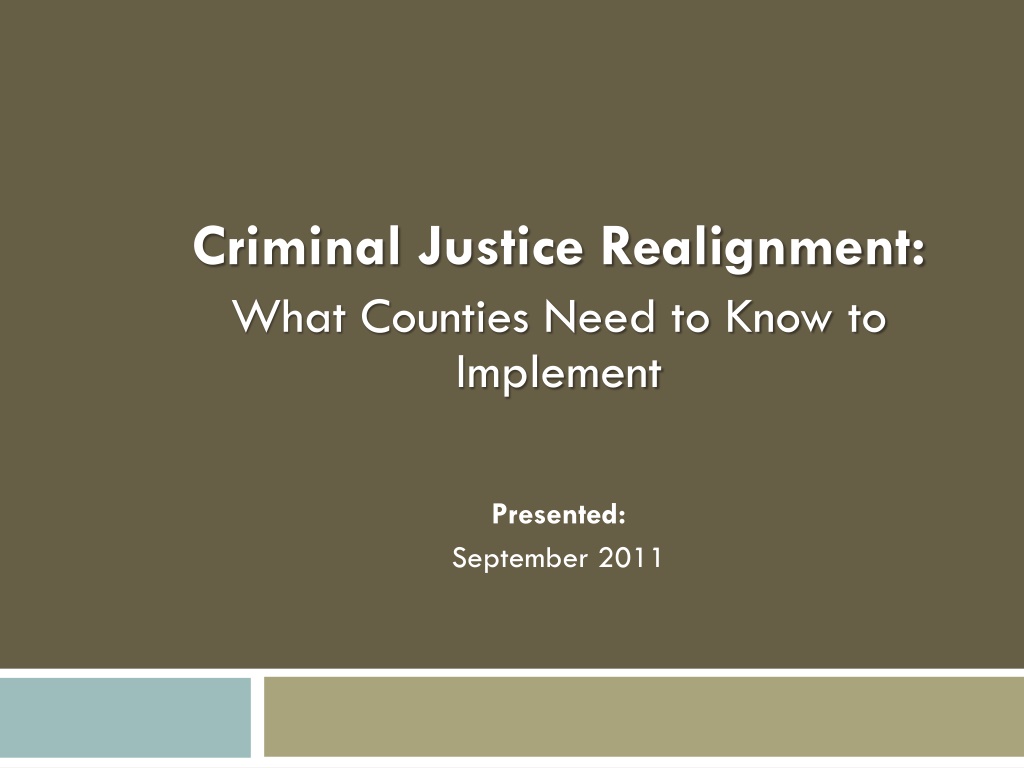


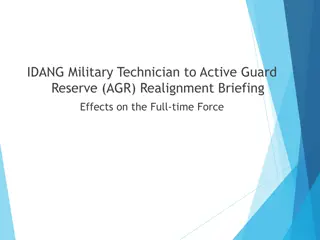
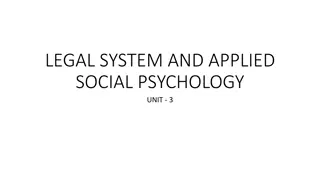

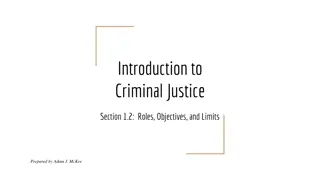

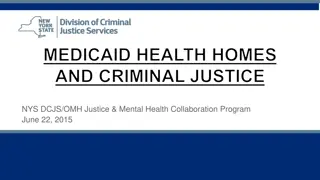



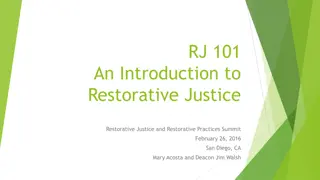
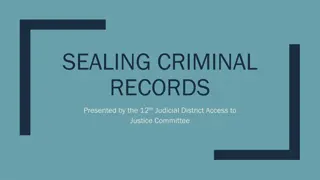
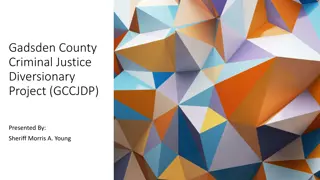
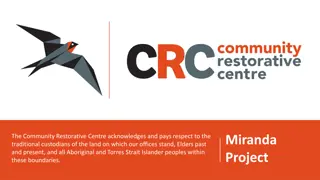

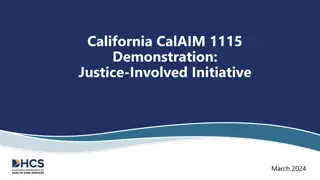



![Briefing on the Criminal Procedure Amendment Bill [B12-2021] to the Portfolio Committee on Justice and Correctional Services](/thumb/157093/briefing-on-the-criminal-procedure-amendment-bill-b12-2021-to-the-portfolio-committee-on-justice-and-correctional-services.jpg)
